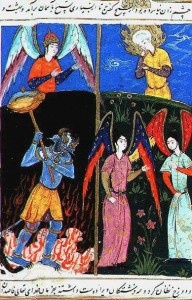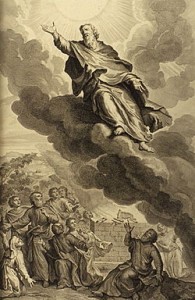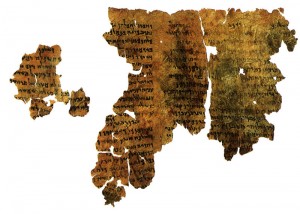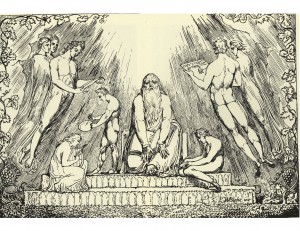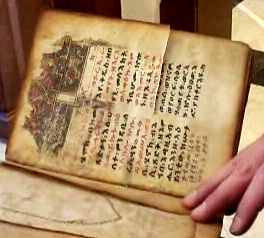And Enoch walked with God and then he was gone, for God took him.
I am investigating a mysterious disappearance. As I am a mere academic, there’s no actual blood involved, but it’s still a puzzling case. Briefly, I am trying to explain why the Book of Enoch vanished as thoroughly as it did, and when it did.
We are living through a “Renaissance of Enoch Studies.” For some forty years now, Enochic literature has been the subject of a substantial and really fine scholarly literature, much of it emanating from the international Enoch Seminar founded in 2000. That group has produced an impressive series of essays, most recently a volume entitled New Perspectives on 2 Enoch: No Longer Slavonic Only, edited by Andrei Orlov and Gabriele Boccaccini (Brill 2012). If the title sounds abstruse, the subject matter is extremely important for anyone interested in Second Temple Judaism, Christian origins, apocalyptic, not to mention rabbinic and Islamic origins. Under the name Idris, Enoch is a venerated Qur’anic prophet. As Metatron, he became an archangel in medieval Jewish apocrypha. Enoch was also a key figure for early Manichaeans.
The Enochic literature has a lengthy history, far too much to be summarized here. Enoch himself is mentioned briefly, cryptically, in Genesis, where his main achievement is disappearing to be with God, seemingly without dying (Gen. 5. 22-29). That potentially gave him an impressive role as an intermediary between human and divine worlds. Even better, his age was given as 365 years, opening the way to astronomical and astrological speculations.
Adding to Enoch’s attraction, Coptic sources credited him with a virgin sister, who was identified with the Sibyl, the prophet who supposedly spoke the Sibylline Oracles. These Oracles were of immense interest to Jews and Christians alike. She was thus assimilated into the Enochic “family.”
From the third century BC onwards, Enoch became the subject of several writings using his name, probably written in Aramaic. Indeed, scholars now speak of Enochic Judaism as a significant form of religious dissidence, connected with the movement represented at Qumran, where several of these works survive. Probably by the first century AD, various segments were brought together to form a work called 1 Enoch. The book as we have it has five sections:
The Book of the Watchers chapters 1-36
The Parables of Enoch chapters 37-71
The Astronomical Book chapters 72-82
The Book of Dream Visions chapters 83-90
The Epistle of Enoch chapters 91-108
The list of titles gives some idea of the incredibly varied nature of the material. 1 Enoch as we have it is a library rather than a book, a grab-bag of the obsessions of the Jewish world in the third and second centuries BC.
1 Enoch, though, was only a part of a much larger body of Enochic literature. 2 Enoch claimed that 360 books were written in the prophet’s name; Muslim historian al-Tabari claimed knowledge of “thirty scrolls.” In modern times, scholars have rediscovered 2 Enoch, probably dating from the first century AD. This survived in Slavonic translation (although Coptic fragments have also been found). The site earlyjewishwritings.com has useful resources on both 1 Enoch and 2 Enoch. Besides those two major early texts, other works attributed to the prophet include 3 Enoch (Sepher Hekhalot).
The most accessible study of the Enochic literature is found in James H. Charlesworth, ed., The Old Testament Pseudepigrapha (two vols., 1983-85). This includes translations and extensive commentary for 1, 2 and 3 Enoch, amounting to over three hundred pages in all.
1 Enoch in particular was enormously influential in its time. Generations of New Testament scholars have been intrigued by the book’s use of the “Son of Man” terminology, recalling Jesus’s own use of that phrase. For centuries, the book’s most intriguing section was the so-called Book of the Watchers, which described how the Sons of God descended to Earth to breed with human women, producing a range of bizarre and frightening monsters. 1 Enoch also gave scriptural foundation for the fascination with angels and archangels like Michael and Gabriel.
Christian writers long treated 1 Enoch as inspired, or at least worthy of respectful attention. Famously, the New Testament Epistle of Jude cites it as scripture. The second century Epistle of Barnabas used Enoch’s writings as inspired, and so did a series of Church Fathers including Athenagoras and Clement of Alexandria. So also, on occasion, did Origen, although he later became skeptical. Barnabas, Athenagoras, Clement and Origen all had Alexandrian connections, but the book’s popularity was not limited to Egypt. Enoch’s wider reputation is suggested by its use in Irenaeus, Tertullian and others. Commonly, such authors cited Enoch’s account of the fallen angels. About 200, Tertullian called Enoch simply, “the oldest prophet.”
Writers of this age rarely shared the concerns of modern believers about the rigid distinction between canonical and non-canonical works, particularly in an age when writings circulated as individual texts. Although Biblical texts were collected, nobody expected the kind of clear standardized uniformity that would become so familiar with the onset of printing. Also, no one authority could possibly impose absolute criteria over a Christian world that already stretched deep into three continents. Despite its critics, Enoch long continued to be read.
From the ninth century though, the book all but vanished, at least from the West. It remained fully canonical in the Ethiopian church, and in 1773 traveler James Bruce brought copies of the Ethiopian text (in Ge’ez) back to Europe. When it was eventually translated in the nineteenth century, scholars began to realize the work’s significance.
But given all its early endorsement, why did 1 Enoch drop out of favor so rapidly? What does this say about the criteria the churches used to frame their Biblical canons? Also, was Enoch’s apparent disappearance as total as it appeared? I’ll address these questions in my next week’s post.


